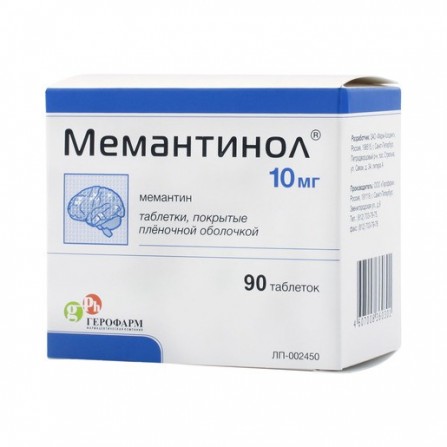Memantinol Coated 10mg N90 Tablets
Condition: New product
998 Items
Rating:
Be the first to write a review!

More info
Active ingredients
Memantine
Release form
Pills
Composition
Memantine hydrochloride 10 mg. Adjuvants: lactose monohydrate - 149.75 mg, microcrystalline cellulose - 27.1 mg, talc - 11.15 mg, colloidal silicon dioxide - 1.25 mg, magnesium stearate - 0.75 mg. The composition of the shell: Opadry; white (lactose monohydrate - 2.16 mg, hypromellose - 1.68 mg, titanium dioxide - 1.56 mg, macrogol 4000 - 0.6 mg) - 6 mg.
Pharmacological effect
Remedy for the treatment of dementia. It is a noncompetitive antagonist of glutamate NMDA receptors (including in the substantia nigra), thereby reducing the excessive stimulating effect of cortical glutamate neurons on neostriatum, which develops against the background of insufficient release of dopamine. Reducing the flow of Ca2 + in neurons, it reduces the possibility of neuroprotective destruktsii.Obladaet, tserebrovazodilatiruyuschim, antihypoxic and psychoactive deystviem.Uluchshaet weakened memory, enhances the ability to concentrate, reduces fatigue and symptoms of depression, reduces spasticity of the skeletal muscles caused by diseases or injuries of the brain.
Pharmacokinetics
After ingestion is rapidly and completely absorbed from the gastrointestinal tract. Cmax is achieved in 3-8 hours. Plasma protein binding is 45%. When taken in a dose of 20 mg / day Css is achieved from 70 to 150 ng / ml. Vd is 10 l / kg. Partially metabolized in the liver. Excreted by the kidneys. T1 / 2 is 60-100 h; ground clearance is 170 ml / min / 1.73 m2.
Indications
Dementia is moderate to severe in Alzheimer's disease.
Contraindications
Severe liver failure; pregnancy; lactation period (breastfeeding); children and adolescents under 18 years of age (efficacy and safety of the drug have not been studied); Hypersensitivity to memantine.
Precautionary measures
Do not exceed the recommended daily dose.
Use during pregnancy and lactation
Contraindicated for use in pregnancy and lactation (breastfeeding).
Dosage and administration
When administered, the initial dose for adults is 5 mg / day. In the future, the dose can be increased weekly by 5 mg. The average maintenance dose is 10-20 mg / day. The maximum dose is 20 mg / day.
Overdose
Currently, no cases of overdose have been reported.
Interaction with other drugs
With the simultaneous use of memantine can reduce the effects of barbiturates and neuroleptics. The effect of baclofen and dantrolene may change under the influence of memantine (with this combination, dosage adjustment may be required). Since memantine and amantadine are antagonists of NMDA receptors, it is necessary to avoid simultaneous use because of the risk of developing toxic action. The combinations of memantine with ketamine, dextromethorphan and phenytoin are also potentially toxic. For the transport of amantadine, cimetidine, ranitidine, quinidine, quinine and nicotine in the body, the same renal cationic system is used, which may cause the interaction of these drugs with memantine to an increase in its concentration in the blood plasma. When used simultaneously, memantine may cause a decrease in the concentration of hydrochlorothiazide in the blood serum. When used simultaneously with warfarino and other indirect anticoagulants require close monitoring of prothrombin time and INR.
special instructions
Caution should be used in patients with epilepsy, renal failure, thyrotoxicosis, history of convulsions, arterial hypertension, myocardial infarction in history, heart failure. In case of renal impairment, the dose of memantine should be reduced.




